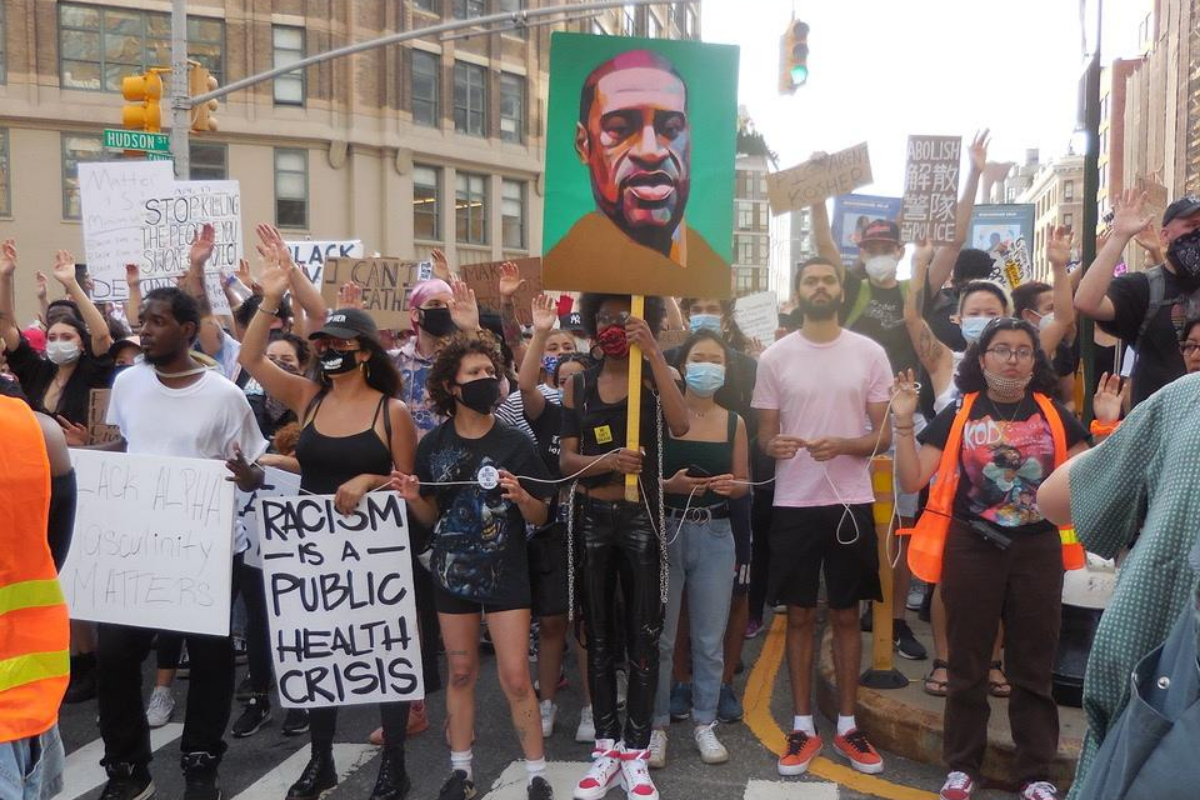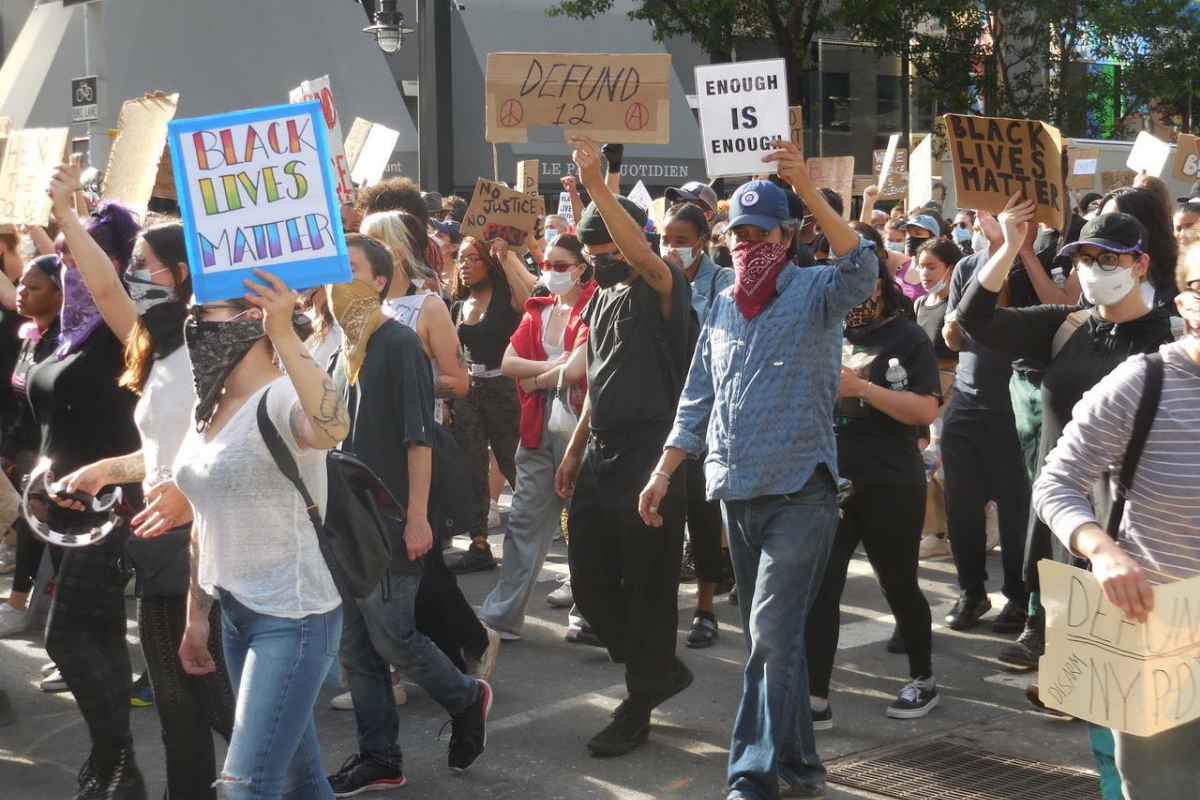

People gather for a George Floyd protest in New York City. (Photo by Louis E. Perego Moreno)
An African-American woman told me once that a white person could never be Black—not even for 24 hours.
I got it loud and clear because I also know bias and discrimination. I am an effeminate, gay male from a machista, Latino culture. I know first-hand the wearing away of the human spirit by a lifetime of walking into a room with your guard up expecting a judgmental stare, a whisper, a not-so subtle glance, or a stranger who has no qualms telling you straight to your face that you’re different and therefore not welcome.
So, if you think George Floyd is the only reason why Americans are angry, think again. The roots of the anger and frustration felt on the streets of the United States grew from decades of social inequality and injustice. In breaking ranks with the Old Normal, and never turning back, it gave birth to a revolution —a multiracial, multigenerational movement against racism and economic injustice, in the middle of a devastating pandemic— made up of many powerful voices who this time refuse to be silenced.
Along the way, there have been many missed opportunities. As an educator, a bilingual Impact Producer of Latino and Black documentary films, a sitting member of the New York City Latin Media & Entertainment Commission, and an Emmy Awards Judge member for the last 25 years, I have been a witness to this waste.
Yet as a strategist and social reformer, my life has been defined by proposing solutions to problems and forging alliances to move causes forward. So here is my two-pronged approach to effecting long-term social change for a more just society in a multicultural and multiracial New York City, one that can be used as a model for the nation.
Education is a top priority. We need to target youth citywide with comprehensive anti-discrimination programs following a step-by-step curriculum for implementation.
Equally important is targeting media and entertainment, which possesses immense power to alter perceptions with its portrayals of marginalized communities. To achieve that goal, it is essential to put people of color in decision-making positions, behind-the-scenes of productions, as well as front and center stage.
But in both areas, there’s also need to create clear parameters to measure the outcomes, which will track improvement and growth for real behavioral and institutional change, as well as replication.
Bring Back the Rainbow Curriculum
In the late ’80s, there were 32 community school districts in the NYC public school system. At that time, “Children of the Rainbow,” a diversity curriculum consisting of 443 pages, initially targeting first graders, was created. Everyone agreed that one should not discriminate against someone against their gender or who was Black, Latino, Native American, Asian, Jewish, Muslim, Christian, or a person with disabilities. However, the moment a small passage was woven into the curriculum about gays and lesbians being part of families, too, an uproar ensued.
The Cardinal of the Roman Catholic Church lobbied against it. The Queens borough president adamantly opposed it and the entire School Board 24 in the same borough was suspended for its refusal to adopt the multicultural curriculum. The pandemonium stoked fear that sodomy and anal sex would be described in graphic detail to small children when discussing gays.
The application of values in a diversity curriculum was intended to impart on children that if their classmate was picked up after school by two mommies or daddies, that they were a family, too.
Sadly, the end result was that by June 1993, controversial Schools Chancellor Joseph A. Fernandez was terminated and the diversity program was shelved. The objective in shaping character development was to expand the three fundamental “r’s’ of education, from “reading, writing and arithmetic,” to include “respect.”
And here we are. The social repercussion is that 27 years later, we have not taught a citywide, age-appropriate curriculum —with measurable outcomes— for K-12 of how males are to respect females, white kids respect Blacks, and Christians respect Muslims. We have the largest school system with 1.1 million youth. It is time to have an all-encompassing, anti-bias, Rainbow Curriculum.
In order to attain the greatest degree of buy-in from the community, its creation and approval should incorporate a diverse group of stakeholders to achieve the broadest dissemination in all our schools, so that 25 years from now these children will be our culturally-competent and sensitive police officers, athletes, banking officers, and government leaders.


Protesters at a George Floyd rally in defense of Black lives. (Photo by Louis E. Perego Moreno)
Media and Entertainment: Altering Portrayals of People of Color
New York City, the number one media market in the country is, according to the NYC Economic Development Corporation, home to 29 multi-billion dollar media companies, more than any other city in the world. In 2018-2019, Broadway drew 14.8 million admissions and generated an all-time high of nearly two billion dollars. We have more television programs filmed here in New York City than Los Angeles. But where are the marginalized folk? Who’s in front and behind the camera?
Every leading media company in NYC has a Diversity and Inclusion division. Having been in the industry over 30 years and played that game, I have little to no respect for many of these departments. I find them highly ineffectual in producing tangible jobs and opportunities for content creators, actors and musicians. Yet, they pontificate beautifully when preaching to the choir or deliver speeches to the other side, but create few results beyond hollow words and the occasional check for a table at an annual “minority” gala.
These departments often work in tandem with Human Resources divisions, given charge to recruit, train administrative staff, and groom for executive leadership. But where does senior management reflect the diverse array of customers who consume their goods? Many from underrepresented communities climbing the corporate ladder complain of getting stuck in middle management and rarely crack the glass ceiling.
At the end of the day, the white “old boys’ club” of senior management are the decision-makers and power players who choose people who look just like them. And if we are not seated at these tables when decisions are made as to what is written, featured on the front cover, performed on stage, nominated for awards, or seated in the orchestra, we are out of the picture. And out of the picture connotes images portraying us in less than authentic or demeaning manners that perpetuate stereotypes.
What is worse than being misrepresented in media? Being omitted.
If our children don’t see themselves in a positive manner, it impacts their psyche, development and self-worth. When our cultural stories are told and we’re not in the mix, the most offensive defense we hear is “but where are those talented actors, singers, writers, directors and producers?” Well, we can tell you indisputably, we are here.
Many of these media and entertainment companies are now pouring their hearts out in the wake of George Floyd’s death, citing shared pain and writing checks.
No one is asking for charity.
We have a bevy of talented professionals who happen to come from disenfranchised communities. Just open the door —not a revolving one— and tear down the walls.
New York City government has a direct relationship with a majority of these media companies with whom they have to strike an agreement or renew a license annually, as the FCC does, with the explicit understanding that they are serving this broad community and providing diverse segments of the population with a voice. In the same breath, they should require an annual diversity report from every media company, monitoring hires with a checklist of diversity backgrounds following standards set by the U.S. Equal Employment Opportunity Commission (EEOC) for employees by title, consultants, and artists in order to keep a scorecard and prove how they are delivering for the wide-ranging voices that truly reflect the city’s demographics.
As local and state governments are fully cognizant and committed with the best intentions for change, the fact is that it is time now for the New Normal moving forward. Beware in recruiting what are called the best minds and most powerful influences to sit on task forces for the rebuilding process. Ensure they are vetted by the community and earned their respect rather than recycling the same leaders and power brokers who perpetuate the same problem comparable to sending wolves to guard the chicken coop.
Having developed comprehensive public health curricula for Latino and Black youth, preventing social, public and mental health issues, when addressing 16 subjects ranging from the prevention of substance abuse to depression and anti-discrimination, a recurring theme was that the first step towards healing is to acknowledge a problem and the second to seek help.
All of this begs more questions than can be answered now. How do you convert protest outrage into action? How do you achieve reconciliation? How can all this unleashed rage live beyond the moment and where do we go from here?
The first step towards meaningful and transformational change is acknowledging there’s a problem. It’s also about forging alliances and building bridges—even by disparate groups who share similar pain that can motivate people to fight for each other’s causes in creating a better tomorrow today.
***
Louis E. Perego Moreno/TíoLouie is the Founder & Executive Producer of PRIME LATINO MEDIA, largest network on the East Coast to the Caribbean of independent Latino multimedia-makers, actors and musicians in English and Spanish. Twitter: @TioLouie.


